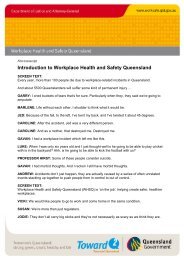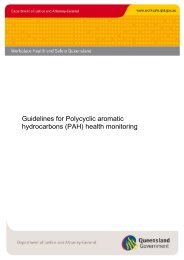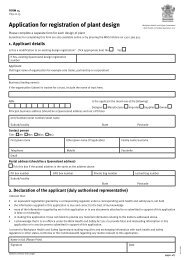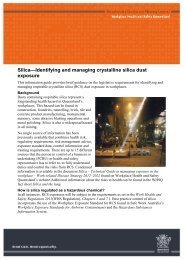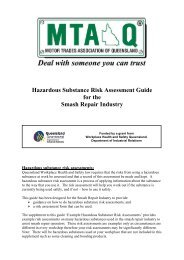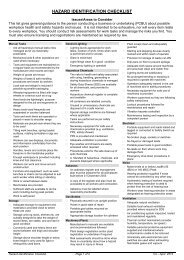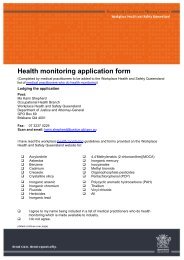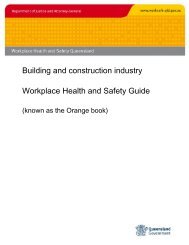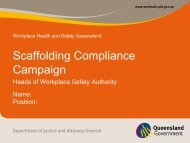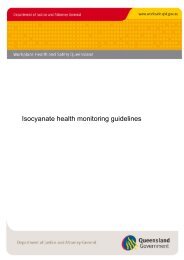DGSM Information Paper No.10 - Spills containment and clean-up ...
DGSM Information Paper No.10 - Spills containment and clean-up ...
DGSM Information Paper No.10 - Spills containment and clean-up ...
You also want an ePaper? Increase the reach of your titles
YUMPU automatically turns print PDFs into web optimized ePapers that Google loves.
3.5 Capacity of spills <strong>containment</strong> systems for package stores<br />
For package stores it is recommended in most circumstances to apply the following approach<br />
to determine the capacity of the spills <strong>containment</strong> system:<br />
100 % of the capacity of the largest package; plus<br />
25 % of the maximum intended storage capacity <strong>up</strong> to 10 000 litres; plus<br />
an additional 10 % of the capacity in excess of 10 000 litres; plus<br />
an additional capacity for fire water.<br />
For example, if a package store contains 15,000 litres of packaged dangerous goods <strong>and</strong> the<br />
largest container is 200 litres, the <strong>containment</strong> capacity would be calculated as follows:<br />
200 + 2500 + 500 = 3200 litres plus additional fire water capacity<br />
3.6 Other Issues<br />
Storage of Incompatible Goods<br />
Occ<strong>up</strong>iers need to ensure that tanks of incompatible dangerous goods are never stored within<br />
the same spill <strong>containment</strong> area. Tanks of incompatible goods should be located in separate<br />
spill <strong>containment</strong> areas.<br />
Incompatible dangerous goods must not be stored in the same spill catchment area because<br />
of the potential for the materials to react dangerously together. Other compatible dangerous<br />
goods may be stored in the same catchment area provided appropriate distances are observed.<br />
At least 3 metres segregation distance would be appropriate for goods that do not react<br />
dangerously.<br />
All incompatible dangerous goods of Packing Gro<strong>up</strong> I or II should be assumed to react<br />
dangerously, unless it can be proven otherwise. Concentrated acids <strong>and</strong> alkalis are examples<br />
of incompatible goods that may react dangerously together.<br />
Distance from containers to bund wall<br />
Bunded compounds need to be constructed so as to ensure that punctures or r<strong>up</strong>tures of<br />
containers do not cause a jet of liquid to pass over the edge of the bund wall. Certain<br />
minimum distances should be maintained between any container <strong>and</strong> its bund wall.<br />
Many Australian St<strong>and</strong>ards recommend at least 1metre distance between a tank wall <strong>and</strong> its<br />
bund wall, measured from the top inside edge of the bund wall to the outermost edge of the<br />
tank surface.<br />
This distance may increase depending on the height of the container. A good rule of thumb is<br />
to ensure that containers sit further from the top inside edge of the bund wall than the line<br />
defined by angle A in Figure 1 3 (the illustration is for a horizontal cylindrical tank on a st<strong>and</strong>).<br />
The distance to the bund wall should ensure that the angle A is more than 26.5˚. In other<br />
words, the ratio of the horizontal distance over the vertical distance from the tank edge must<br />
be greater than 0.5.<br />
3<br />
Adapted from Figure 5.2(b) in Australian St<strong>and</strong>ard AS 1940 “Storage <strong>and</strong> H<strong>and</strong>ling of Flammable <strong>and</strong><br />
Combustible Liquids”.<br />
<strong>DGSM</strong> <strong>Information</strong> <strong>Paper</strong> No. 10 <strong>Spills</strong> Containment <strong>and</strong> Clean-<strong>up</strong> (December 2003)<br />
CHEM Services, Department of Emergency Services Page 4





